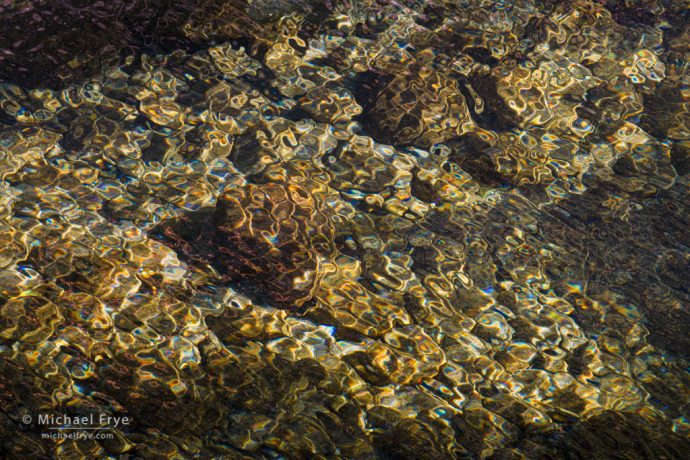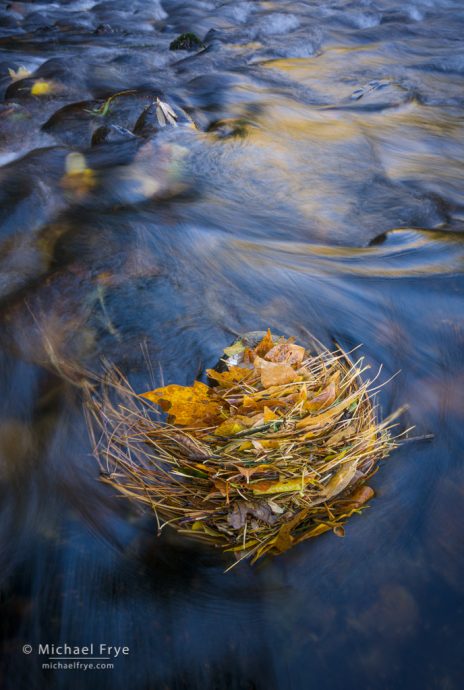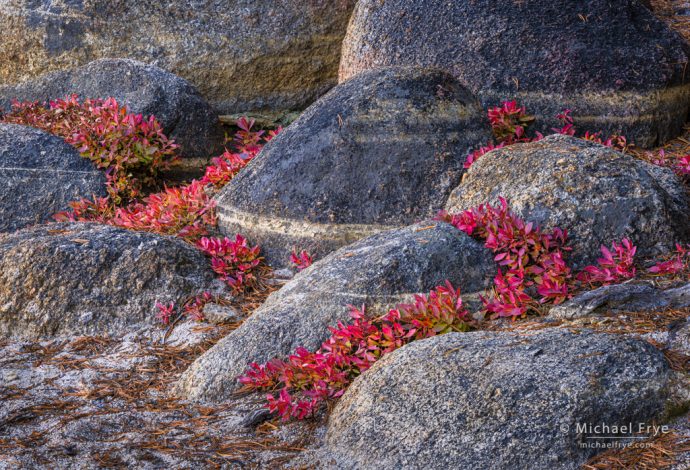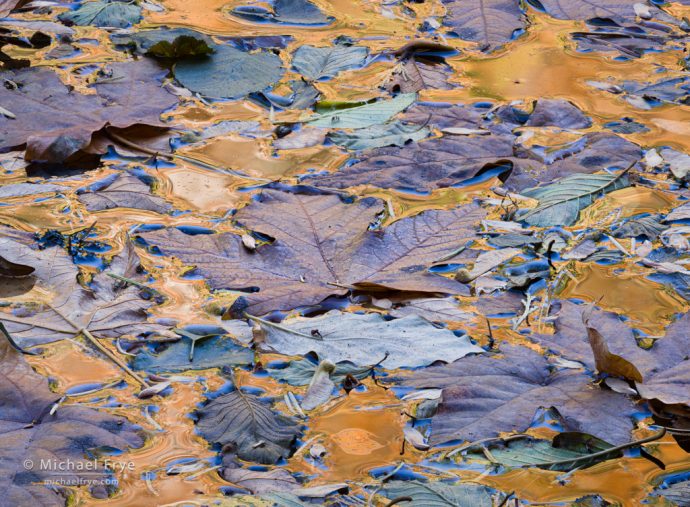
Rocks and ripples in the Merced River, Yosemite. Claudia, Charlotte Gibb, and I noticed some interesting patterns in the water while wandering along the river last year. I made a few compositions at one spot, then moved downstream, where I found Claudia and Charlotte looking at similar patterns with prism effects – little squiggly rainbows flashing across the water. I made a couple of photographs I liked last year, but then went back to that same spot last month, and this time found a sunlit patch of water surrounded by tree shadows, which gave the pattern a natural vignette. I needed a fast shutter speed to freeze the motion of the ripples, and a small aperture to keep everything in focus, so I raised the ISO to 1600 to get the shutter speed up to 1/125th sec. at f/16. The focal length was 200mm.
Landscape photographers usually hope for great conditions: a clearing storm, sun breaking through fog, a spectacular sunset, great fall color, dense patches of wildflowers, and so on.
I wouldn’t say it’s easy to make good photographs under such conditions. You still have to put yourself in the right place at the right time, find a good composition, and get the exposure and focus right. And all of those things take skill. But it’s certainly easier. In those highly-photogenic situations you just have to capture the gift that nature is giving you.
When conditions aren’t so optimal you have to dig a little deeper. There’s nothing obvious to point your lens at, so you need to look harder to find ways to make compelling photographs. And I think that can be a good thing. It can push you to be more creative. You know you’re not missing a spectacular sunrise somewhere, so you can take the time to really look at your surroundings, and notice things you might otherwise pass by.
It’s been a very dry autumn in California. While we don’t expect a lot of rain in the fall, we usually get a few storms to break the summer drought. But this year it hasn’t rained at my house, or most locations on the western slope of the Sierra, for months. The last measurable precipitation in Yosemite Valley was on September 16th: a hundredth of an inch. Prior to that the valley got fourteen hundredths on July 25th.
We did, however, get some unusually cold weather in October, and those cold snaps seemed to take their toll on the fall color, both in the eastern Sierra and in Yosemite Valley, making leaves turn brown instead of yellow. We still found nice patches of color here and there, but we had to look a little harder. And without blazing fall color, or interesting weather, easy compositions were in short supply. I had to dig a little deeper.
If I’m in a familiar location with nothing obvious to photograph, I often ask myself “What’s happening now?” What’s different or unusual about the conditions at this moment? That question might spark an idea about where to go to find something interesting.
My focus is usually on smaller scenes, because I’ve learned that it’s still possible to make compelling intimate landscapes even when the light, weather, and conditions aren’t particularly inspiring. Once I arrive somewhere, I’ll often just wander around and see what catches my eye. I try to avoid preconceived ideas, and remain open and receptive to everything. I try to let my instincts and intuition guide me.
I’ve included a few photographs here from my autumn wanderings around Yosemite, with extended captions to explain how I made each image. These photographs are on the quieter side, which probably reflects my mental state when meandering and looking for compositions.
When conditions are less-than-spectacular, your inspiration has to come more from within, rather than from obvious outside stimulation. If you can let go of preconceived ideas and expectations, and follow your instincts, you might end up capturing something you like – and perhaps different from anything you’ve done before.
— Michael Frye

Leaf stack in the Merced River, Yosemite. Some colorful cottonwood trees caught my attention and drew me to this stretch of the river. I couldn’t find a good composition for the cottonwoods, but noticed these maple and cottonwood leaves stacked against a rock above a small rapid. I was wearing chest waders, since I knew I might need to go in the river, so I waded carefully out to the rapid. The leaf stack provided a nice focal point, which I then juxtaposed with the gold reflections. To keep the composition simple and clean I got close to the leaf stack with a wide-angle lens (20mm), and pointed the camera down to eliminate the riverbank, which was just above the top of the frame, and full of messy, cluttered branches. 1/2 sec. at f/16, ISO 100.

Blueberry leaves and granite boulders, Yosemite. I made this image during our Eastern Sierra workshop last month. One afternoon we drove up to the Yosemite high country, where some red blueberry bushes near the shore of a lake caught my eye. Good compositions eluded me at first, but I kept looking, and eventually found this pattern of red leaves and rounded boulders. 135mm, 1/2 sec. at f/16, ISO 100, focus stacked.

Leaves and reflections in the Merced River, Yosemite. I made this image just upstream from the leaf-stack photo. My attention was caught by gold reflections in the water, from sunlight hitting an oak tree across the river. What could I do with that? I saw some maple and alder leaves in a pool near the edge of the river, so I found a way to climb down the steep bank, got down low to get the right angle for the reflection, and found this composition, with a large maple leaf providing a focal point. 200mm, 1/3 sec. at f/16, ISO 100, focus stacked.
Related Posts: Can Intimate Landscapes Have a Mood?; What’s Happening Now
Michael Frye is a professional photographer specializing in landscapes and nature. He is the author or principal photographer of The Photographer’s Guide to Yosemite, Yosemite Meditations, Yosemite Meditations for Women, Yosemite Meditations for Adventurers, and Digital Landscape Photography: In the Footsteps of Ansel Adams and the Great Masters. He has also written three eBooks: Light & Land: Landscapes in the Digital Darkroom, Exposure for Outdoor Photography, and Landscapes in Lightroom: The Essential Step-by-Step Guide. Michael has written numerous magazine articles on the art and technique of photography, and his images have been published in over thirty countries around the world. Michael has lived either in or near Yosemite National Park since 1983, currently residing just outside the park in Mariposa, California.









Very profound, nice.
Thank you for this article. This is something I try to do. I always say, each visit to place “X” is different and you take what you are given. I really don’t need a shot of Half Dome with clear blue sky, for example, so if I am with folks that are on their first visit and want to take that shot, I look elsewhere (usually downwards).
Really good reminder for any place you are visiting.
Glad to hear that you’re doing this Doug!
I just should have read your post a little earlier, since i am just back from a quiet unsatisfying trip to the surrounding landscape of my home. It was raining and hazy, and i was looking for some spectacular scene, but couldn’t finde one. So i returned home without having fired the shutter. Now i am quite a bit sore and sulky about myself and my mental state, and of not having had the idea of digging a little deeper. As a result, i am quiet sure that i missed many ways of making compelling photographs due to your thoughts. But for the future, according to your advice, i am looking forward of not doing this failure again.
Well better late than never I guess! I hope this helps going forward.
Hi Michael – This is just a quick note to say that I have been enjoying all of your recent blog posts. They are so well done and share important messages for photographers exploring creativity and seeking ways to express themselves. It is nice to see so much thoughtfulness among the morass of low-quality photography content that seems so common today.
Thanks so much Sarah – high praise coming from you!